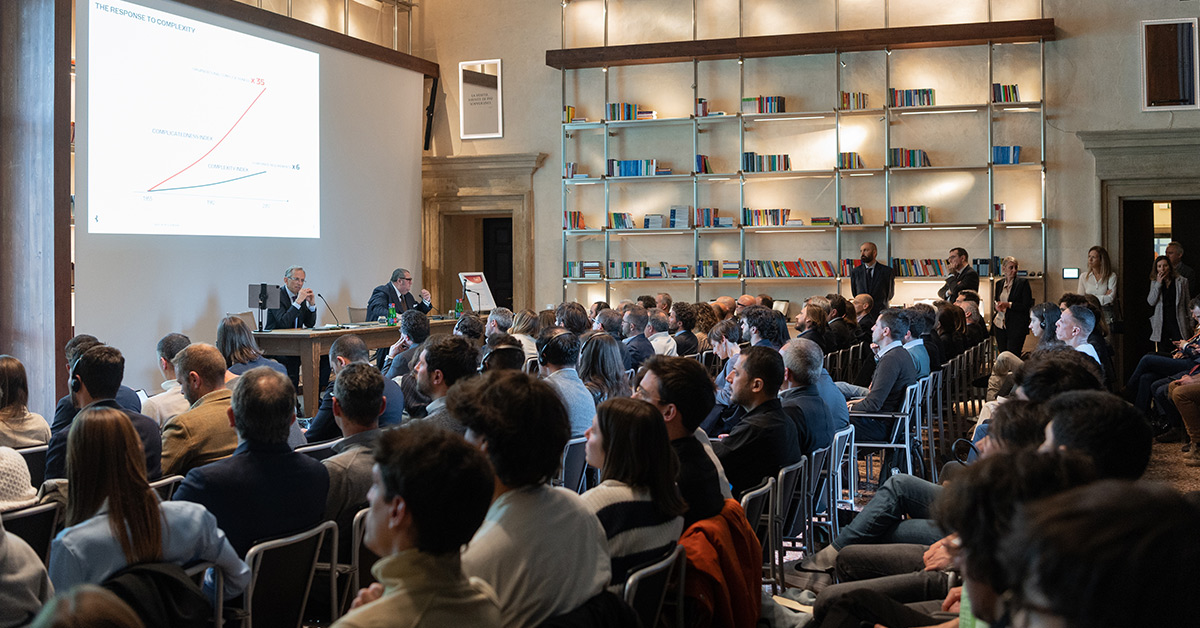
BBS Leadership Lecture | Leading Through Innovation | Benedetto Vigna
19 April 2023The last appointment with the Leadership Lecture at Villa Guastavillani. On March 29th, BBS Dean Max Bergami presented Benedetto Vigna, CEO of Ferrari, who spoke about innovation and leadership.
CEO of Ferrari since September 2021, Benedetto Vigna, is a physicist with a significant scientific background and one of the most well-known Italian business executives. He Graduated with honours in Subnuclear Physics from the University of Pisa, and gained his first work experience at prestigious institutions such as the CERN in Geneva, the Synchrotron in Grenoble, and the Max Planck Institute in Munich. In 1995, he began working for STMicroelectronics, forming the group of researchers who launched the company’s commitment to MEMS (Micro-Electro-Mechanical Systems). Thanks to his team, Vigna created a three-dimensional motion sensor called “Monviso”, which revolutionized the world of cars and video games. Vigna was included in the list of twelve candidates for the “European Inventor Award 2010” for this invention. With over two hundred registered patents, Benedetto Vigna is considered one of the best managers in our country, as demonstrated by his inclusion in Forbes Italy’s list of the top 100 Italian managers.
It was precisely from the theme of complexity that the manager’s Lecture started, explaining how today’s world is undoubtedly complicated but not as complex as is often thought and especially not much more so than in the past. Objective complexity has grown less than the complications that have been added, making it all the more difficult to manage. “Complexity cannot be reduced or simplified. It can only be managed,” explained Vigna. “Like all things outside ourselves, there is little we can do”. But what does complexity in a company refer to? Vigna cites various aspects, from those related to technologies to those related to manufacturing, focusing on an aspect often overlooked, that of complexity even in marketing campaigns, which can determine the success or failure of a product, as demonstrated by the example of the launch of Apple’s first Mac. At the heart of it, all is the need to manage change, which Vigna invites us to look at the past as well: “We forget that these problems have been addressed excellently by many people who preceded us, and often, in my opinion, the solution to the problems can be found in previous texts.” A look to the past can, paradoxically, foster innovation and provide direction to the leadership that must guide it in the company.
But what drives innovation today as it did in the past? “I think innovation comes from scarcity and that the best way to innovate is to limit resources.” In fact, according to the CEO of Ferrari, the more resources are used, the less innovation is done because infinite resources do not stimulate creativity and do not allow the human element to be valued. Another pillar of creation comes from the need to find a solution by optimizing existing resources: the ability to challenge the status quo. “The first thing to do is to be challenged with questions, new perspectives that question what is considered established theories.” Innovation leaders must also identify emerging trends and direct an unmet need. Finally, it is essential to leverage one’s strengths, which can be the key to finding innovative solutions.
Vigna highlighted each point with concrete examples; real cases learned and experienced over time not only in Ferrari but also in previous positions held in research, which have allowed him to notice how innovation is often identified only with product innovation, neglecting innovation in areas such as organization, technical solutions, technological solutions, and marketing campaigns. “I find it curious to observe,” he explained, “how often innovation is talked about only in terms of the product: people think of the most beautiful car, cell phone, and satellite. But there is often a lack of reflection on how that product, that result was achieved, in other words, on the process, which is a fundamental part that I put on the same level as the product.”
The CEO of Ferrari also emphasized the importance of dealing with innovation in terms of management. The latter aspect has to do with cultural transformations within the company, which must occur gradually, step by step, involving people as the main asset of any business. In this sense, the possibility of networking thanks to the Internet is a great advantage to find not only people but also partner companies that can contribute to developing the potential of an innovative idea.
In conclusion, leadership based on innovation requires the ability to manage the complexity of the contemporary world, to be able to question the status quo and identify new needs to be met, leveraging one’s strengths. But not only that, Vigna invites tomorrow’s managers to cultivate patience (innovation is neither quick nor immediate), value people, consider sustainability and be aware that leadership is, first and foremost, a commitment to be cultivated every day: “The point is that one must be aware that to be a leader, one must always behave as such, not give in, never relax too much by taking for granted a position that is not psychologically simple but, with experience, is learned to be managed without ever stopping at the first interpretation.”
Read other articles on BBS Leadership Lecture: Lihi Zelnik-Manor, Mauricio Macri, Stefano Venier, George Lee, Lisandroni e Stefanelli.
